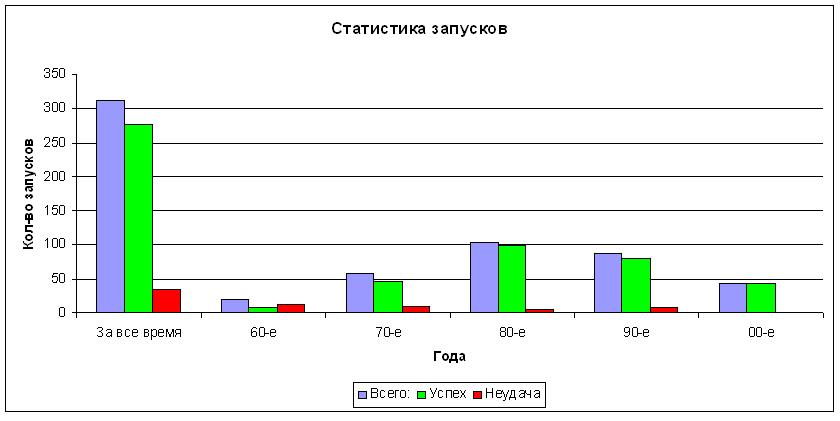Launch vehicle launch statistics in the USSR and the Russian Federation
Good afternoon, dear habrovchane.
Continuing the week of astronautics in Habré, I want to present a small statistic on the launch of launch vehicles. So far, only Proton-M and Proton-K have been considered; if there is still free time, I will try to add data for others.
Startup data taken from Wikipedia.
The Proton-K launch vehicle (PH), a heavy-class rocket, was developed on the basis of a two-stage LV UR-500 with some changes at the second stage and with the addition of the third and fourth stages.
The first successful launch is indicated under the date March 10, 1967.
The latest launch is dated March 30, 2012, before that - February 28, 2009. I’ll give statistics until 2009, because one launch (successful) in the overall picture does not make sense.
So, numbers and diagrams:
Total launches: 311, of which 277 successful and 34 failures.
')
The situation by year (in segments of 10 years) is as follows:

Accordingly, the statistics on the percentage of failure is as follows:

As we can see, at first, the percentage of unsuccessful purchases was simply terrifying (up to 65%), but then it dropped noticeably and, according to available data, in the zero years there were not a single unsuccessful for 44 launches.
Among the causes of accidents, two of the most common are: failure of the 2nd stage and failure of the upper stage “D”. By the last years, these problems were apparently finally eliminated.
What pleasantly surprised me was that even in the troubled 90s the number of launches did not decrease as much as they could, and the overwhelming majority of launches were in the interests of our country, for the output of their own satellites.
Since 2001, Proton-K has been gradually replaced by its upgraded version of Proton-M. More details can be found in the article on Wikipedia , but if it is short, then the M version has updated the control system, increased the payload tonnage, improved the fuel system and several more buns. However, this upgrade has led to less comforting statistics.
Over 12 years, 74 launches were made, 7 of them were failures and 1 dubious moment with a premature disconnection of the device from the upper stage. Then the satellite reached the desired orbit on its engines. If undoing occurred earlier, the satellite would be lost. I recorded the case in the equipment failures section though.

I remind you that Proton-K made 45 launches in the same year (including the last in 2012) with 100% success.
Thus, we see that the notorious Proton-M shows the percentage of failures in the first years is still significantly lower than its predecessor. On the one hand, the problem of “childhood diseases” is known and, in principle, inevitable. But on the other hand, Proton-M is still a modification of a fairly successful rocket, so 11% of failures personally seem to me unacceptable (especially considering the current price of one launch of 2.4 billion rubles).
Continuing the week of astronautics in Habré, I want to present a small statistic on the launch of launch vehicles. So far, only Proton-M and Proton-K have been considered; if there is still free time, I will try to add data for others.
Startup data taken from Wikipedia.
The Proton-K launch vehicle (PH), a heavy-class rocket, was developed on the basis of a two-stage LV UR-500 with some changes at the second stage and with the addition of the third and fourth stages.
The first successful launch is indicated under the date March 10, 1967.
The latest launch is dated March 30, 2012, before that - February 28, 2009. I’ll give statistics until 2009, because one launch (successful) in the overall picture does not make sense.
So, numbers and diagrams:
Total launches: 311, of which 277 successful and 34 failures.
')
The situation by year (in segments of 10 years) is as follows:

Accordingly, the statistics on the percentage of failure is as follows:

As we can see, at first, the percentage of unsuccessful purchases was simply terrifying (up to 65%), but then it dropped noticeably and, according to available data, in the zero years there were not a single unsuccessful for 44 launches.
Among the causes of accidents, two of the most common are: failure of the 2nd stage and failure of the upper stage “D”. By the last years, these problems were apparently finally eliminated.
What pleasantly surprised me was that even in the troubled 90s the number of launches did not decrease as much as they could, and the overwhelming majority of launches were in the interests of our country, for the output of their own satellites.
Since 2001, Proton-K has been gradually replaced by its upgraded version of Proton-M. More details can be found in the article on Wikipedia , but if it is short, then the M version has updated the control system, increased the payload tonnage, improved the fuel system and several more buns. However, this upgrade has led to less comforting statistics.
Over 12 years, 74 launches were made, 7 of them were failures and 1 dubious moment with a premature disconnection of the device from the upper stage. Then the satellite reached the desired orbit on its engines. If undoing occurred earlier, the satellite would be lost. I recorded the case in the equipment failures section though.

I remind you that Proton-K made 45 launches in the same year (including the last in 2012) with 100% success.
Thus, we see that the notorious Proton-M shows the percentage of failures in the first years is still significantly lower than its predecessor. On the one hand, the problem of “childhood diseases” is known and, in principle, inevitable. But on the other hand, Proton-M is still a modification of a fairly successful rocket, so 11% of failures personally seem to me unacceptable (especially considering the current price of one launch of 2.4 billion rubles).
Source: https://habr.com/ru/post/185664/
All Articles